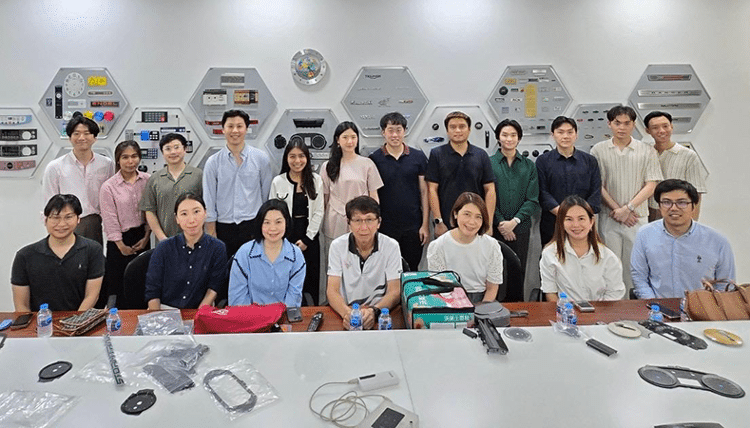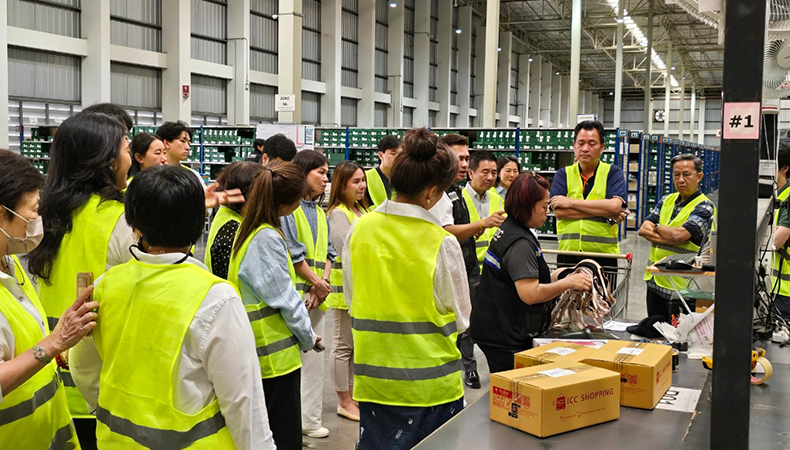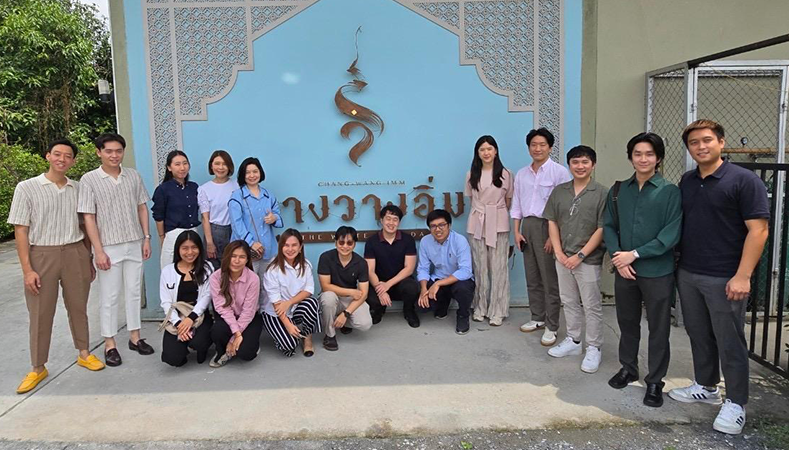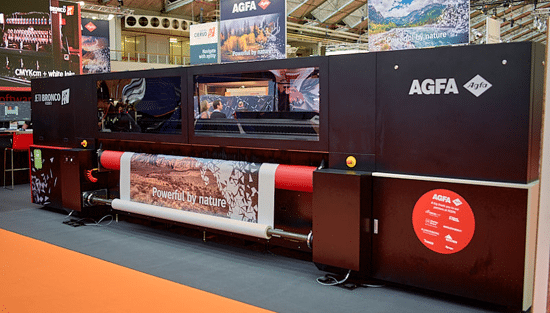FESPA in Thailand: TINPA goes from strength to strength

Grace Paksookchai, Board member of TINPA, the Thai FESPA Asssociation, describes the challenges of sustainability and investment to the industry in Thailand.
Grace, tell us a little about your career.
After four years at the University of Edinburgh, I returned to Thailand to join the family business. I’m the second generation of our printing supplies company, Foilmaster (Thailand) Ltd. The business is 35 years old, and I have been a part of it ever since high school, attending exhibitions and meetings abroad with my father.
My late grandfather ran a printing house, and he encouraged my parents to start up their own printing-related business.
We are now expanding and diversifying our product range, going beyond just stamping foils. We now distribute heat transfer flex, vinyl stickers, special effect tapes and thermal transfer ribbons. We are looking for partners to join us in our growth in the Thai market.
What direction is TINPA heading this year?
We try to focus on several key areas to ensure relevance and support for our members in the evolving printing industry and other related industry. We will continue to prioritise and take into account the original visions of previous TINPA presidents and will allow this to guide our future plans.
 TINPA members, TSDC Fulfilment Centre
TINPA members, TSDC Fulfilment Centre
The following strategies have been added to our objectives this year in order to adapt to current printing technologies.
- Market research and insights: Provide valuable data and analysis on industry trends, consumer preferences, and market opportunities to help members make informed business decisions.
- Digital transformation: Encourage members to embrace digital printing technologies, automation and integration with digital media to stay competitive in an increasingly digital marketplace.
- Innovation and technology showcase: Organise events or expos to showcase the latest technologies and innovations in printing, encouraging members to adopt new tools and methods.
- Customer engagement strategies: Help members develop strategies for enhancing customer relationships, including personalised services and value-added offerings.
- Global collaboration: Foster international partnerships and collaborations to share best practices, learn from global trends, and expand market opportunities for members.
How are TINPA membership levels performing?
We are steady at 156 companies in 2024, with one new recruit, and 155 companies in 2023, with four new recruits.
In July, TINPA organised a warehouse visit to the TSDC [Tiger Distribution and Logistics Company] fulfilment centre. The objective was to give an alternative to entrepreneurs who were in the print industry but did not want to invest in warehouse and delivery. We also invited non-members in different industries to join the activity to raise the awareness of our association. The activity was well received, with almost 30 people registered to attend.
Have you seen any demographic changes in members?
There is an increasing number of younger, second/third generation members in the association. In the past, the majority of our members were in the screen printing industry, but now they are more diversified throughout many printing sectors such as digital, flexo, signage, automotive and many other post-press processes.
What are the strengths and weaknesses of the Thai print industry and its weaknesses?
The Thai printing industry is one of many manufacturing industries in Thailand: automotive, electronics, processed food, personal care and household products, for example. This allows for the development of printing techniques where many print specialists in Thailand can thrive. Thai culture pays close attention to fine detail, as seen in much traditional Thai art. We are very delicate and specific in our ways, which transfers into our prints and their high quality.
We also have a taste for humour and melodrama and employ them in creative ways. Thai videos and movies are popular among Asian communities and win awards for their creativity.

TINPA Youth, Changwangimm Restaurant
However, many companies are divesting their interests from Thailand because of the instability in macroeconomics and political conditions. Much government spending is directed towards the tourism and services industries, with minimal concern for the manufacturing industries. With little support from the government, there is not much the private sector can achieve alone. It seems we can only follow, not set, trends in almost all regards, including developments in sustainability. Sustainability is a challenging issue for Thailand: we are one of the countries most affected by global warming, yet we are the least concerned. Print jobs only go where the money is, and with no regulations from the government, the cheapest, most effective material always wins.
How hard is it to recruit and retain print workers in Thailand?
For lower-level jobs, it is not too difficult to recruit workers. However, it is a challenging task to retain them as they are always looking for better opportunities or new experiences. The younger workforce doesn’t stay in one place for as long as generation X or baby boomer staff. The minimum wage has increased in Thailand, so it is more expensive to recruit, and many factories are resorting to recruiting immigrants instead of Thai workers.
What efforts is TINPA making to attract young people?
We have made attracting young people one of our top priorities. Since we already have a network of current business owners in printing, initially we invited their successors to come in for a introductory lunch or dinner to share ideas and experiences of working in the family business. We believe that it is important for these youth groups to form relations in which new business ideas may prosper in the future. Following these monthly meetings, we then started to add other activities: for instance, a bowling charity event, orphanages, factory visits and new year parties.
The younger generations like to work among people they respect, who share similar values. Connecting them, allowing them to see that other people are facing the same problems they think are unique to them, will increase the retention rates of these second/third generations.
 Grace Paksookchai, TINPA
Grace Paksookchai, TINPA
We also reach out to universities and give information about the printing industries to students who are interested. We hold competitions in which students can compete for monetary and opportunity prizes, raising the awareness of the industry to attract more young people.
On 2 August, TINPA Youth Group organised a factory visit to Thai Techno Plate Co Ltd. Its main products are nameplates, membrane switches and keypads used in the electronics and automotive industry. The objective was to share knowledge and strengthen business relationships between the younger members of TINPA. We also invited non-members in the printing industry to attend the visit and encourage them to become members of TINPA New Gen. The activity was well received, with almost 20 people (maximum capacity) registered to attend.
What is your opinion on mass customisation/personalisation in the industry? Has it reached full potential?
Digital printing has made personalisation easier, especially in the fast print signage and labels industry where many have adopted digital machines. It seems these machines are capable of running at almost the same speed and accuracy as traditional methods, but cost per print is still one of the limiting factors for the technology in Thailand.
What kind of role do you see artificial intelligence (AI) playing in the industry?
AI has already seeped in and is slowly becoming part of the industry. Whether it be using ChatGPT to make the way we work more efficient or incorporating higher levels of AI technologies into the production line, we are already using them one way or another. It is highly convenient to use AI in pre-press, and saves time in concept designing.
We see AI being employed in the quality control of print jobs, checking and highlighting discrepancies in the master artwork and the printed artwork. However, many other areas of printing are still labour intensive, with many jobs being custom print.
What is the value to TINPA of attending FESPA’s exhibitions?
Every year, FESPA updates us on the current trends and where the market is heading. It is a place where we meet and connect with people in the industry, exchanging ideas and perspectives. The dynamic atmosphere at FESPA helps facilitate business collaborations unlike any other exhibitions.
What does the year ahead hold in terms of trends/new technology?
Clearly, as I mentioned, we really cannot escape the influence of AI and sustainability. Those are the hottest words for the industry right now. Following the EU and US regulations, all the materials used in printing are getting dressed up one way or another to present a greener front. Whether or not it is truly green is a completely different issue!
We are starting to see a shift from soy ink to bio-based ink, and the demand for more transparency in the percentage of bio-based raw materials used in the ink. Many Thai printers exporting to the EU and US are now asking about biobased and de-inkability. Ever since the EU banned the use of laminated metallised paper, we start to see those printers exporting abroad, substituting stamped foils.
Anything else you'd like to tell FESPA members about?
It has been many years since FESPA came to Thailand, and we would be very honoured to host you again!
Become a FESPA member to continue reading
To read more and access exclusive content on the Club FESPA portal, please contact your Local Association. If you are not a current member, please enquire here. If there is no FESPA Association in your country, you can join FESPA Direct. Once you become a FESPA member, you can gain access to the Club FESPA Portal.
Recent news

The personal touch: visit Personalisation Experience’s SmartHub Conference 2025
Join the SmartHub Conference at Personalisation Experience next month to stay ahead of the latest tech and trends.

How to build brand trust using customer reviews
Reviews can benefit or damage your business’s reputation. From spreading the word to social proof, here is why reviews matter and what you can do to manage your customer reviews to improve your brand’s reputation.

Regulation guidance: Extended Producer Responsibility
Extended Producer Responsibility (EPR) is now in effect. What does it mean for those in the print industry? Sustainability consultant Rachel England outlines everything you need to know.

How to maximise the automation of your production workflow
Workflow automation has evolved beyond basic file prep, now encompassing job submission, prepress, and postpress. Printers automate to boost productivity, cut waste, and address skill shortages. Implementing tailored automation, from RIPs to MIS, optimises throughput and profitability, minimising human intervention.